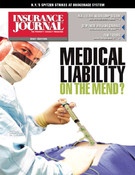Some Predicted Reality TV Would be Tough to Cover But Insurers Have Reduced the Risks
Jon Paulsen was one of millions of TV viewers watching as contestants on the NBC reality show Fear Factor went bobbing in a vat of lard for cow tongues.
But gross-out entertainment wasn’t the reason Paulsen stared as the scantily clad competitors dipped their heads into the gooey, melted animal fat to grab the cow tongues with their teeth. Paulsen is chief underwriting officer of the entertainment division at the St. Paul Travelers Cos. Inc., which insures Fear Factor and several other popular reality shows. Three weeks before that show aired last month, Paulsen and his team of risk-control analysts questioned, analyzed and triple-checked every detail of the stunt. The cow tongues had to be certified as safe to eat by the U.S. Department of Agriculture; the lard had to be fresh from a supermarket freezer.
“Watching television has changed for me,” Paulsen said. “I chew my nails hoping they do exactly what they said they would.”
Experts say reality shows might not exist were it not for a few big insurance companies, including St. Paul Travelers, American International Group of New York and Fireman’s Fund Insurance Cos. of Novato, Calif.
Before Fear Factor contestants can leap from helicopters or Survivor participants can paddle up a muddy jungle river in Brazil, producers must find companies to insure them in case someone breaks a limb, returns home with mental scars, or worse.
The potential rewards are high for insurance companies. Insurance rates on a reality TV show with physical stunts can be 20 to 50 percent higher than a standard program shot in a studio, Paulsen said. Last year, St. Paul Travelers collected about $110 million in premiums from its entertainment unit, with a portion of that from reality programming, Paulsen said. “For now, reality TV is the fastest-growing segment of the entertainment insurance industry,” he said.
It wasn’t long ago that some media analysts predicted the genre would fail because it would be too difficult to insure. But few incidents have occurred, partly thanks to insurance companies working behind the scenes to remove risks, the analysts say.
“One death. One dismemberment. That’s all it could take to end reality television,” said Kenneth Wefer, owner of LMC Group, an engineering company that helps insurers evaluate stunts. “That’s why it’s crucial that insurers are involved. … Without them, reality TV might not exist.”
But the risks are growing as networks come under pressure to grab viewers with fresh stunts and more offbeat concepts.
“We do insure some reality TV, but it is getting more and more difficult as the shows get increasingly outrageous,” said David Hilgen of the Chubb Group in Warren, N.J.
A few upset contestants have sued. Philip Zelnick is suing Candid Camera for persuading him to go through an airport X-ray machine. Zelnick claimed he suffered bruises and bleeding after he got stuck. James and Laurie Ann Ryan are suing MTV’s Harassment for emotional distress. They checked into a Las Vegas hotel to find a fake body in their bathroom, and a guard and paramedic who stopped them from leaving.
Contestants typically sign promises not to sue, but a sympathetic judge can dismiss these waivers if producers are found to be negligent.
“If someone is seriously hurt, they will find ways to poke holes in the waivers,” said John Hamby, senior vice president at Marsh Inc. of New York.
That’s why Paulsen and his colleagues at St. Paul Travelers take their jobs seriously. Specialists analyze scripts to see if producers are putting people at risk of bodily or psychological injury. Often, they will visit the stunt sites to check whether the equipment is in good condition.
Paulsen doesn’t approve every script. The company recently declined to insure a hidden camera stunt that called for people to jump out of a plane after the pilots pretended the engine was failing. “What happens if the parachutes don’t open or if the plane crashes?” Paulsen asked.
So far, the biggest loss St. Paul Travelers has suffered is $200,000 to replace four cameras that got wet while filming on a tropical island.
“Right now, I feel [the producers] have engineered out most of the risks,” Paulsen said. “But if this push for bigger, better means someone gets significantly injured, then all bets are off.”
Topics Carriers
Was this article valuable?
Here are more articles you may enjoy.


 Harvard Study Again Stirs the Pot on Demotech Ratings of Florida Carriers
Harvard Study Again Stirs the Pot on Demotech Ratings of Florida Carriers  Wildfires Are Upending Some of the Safest Bets on Wall Street
Wildfires Are Upending Some of the Safest Bets on Wall Street  Coral Gables, Florida Tops Beverly Hills as Ritziest Home Market in US
Coral Gables, Florida Tops Beverly Hills as Ritziest Home Market in US  Vintage Ferrari Owners’ Favorite Mechanic Charged With Theft, Fraud
Vintage Ferrari Owners’ Favorite Mechanic Charged With Theft, Fraud 


